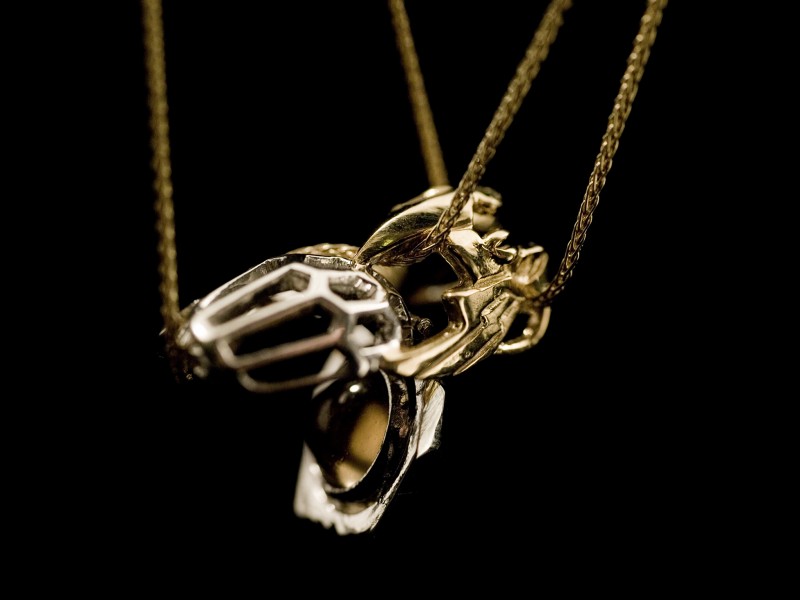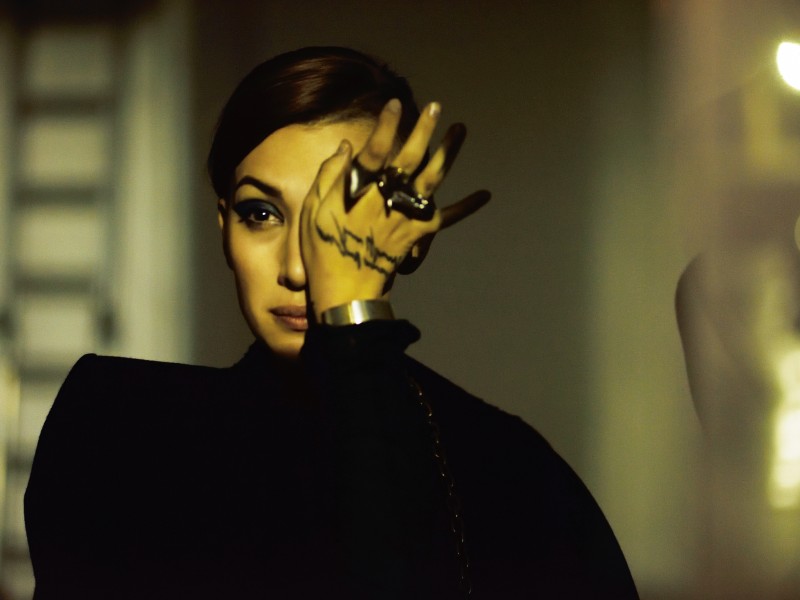Nicola Formichetti never met Andy Warhol—their lifespans overlapped by ten years—but refers to the American artist as his “dream teacher”. Their post-mortem union transpired when Formichetti launched the Welcome to Diesel World Exhibition in Melbourne in March of 2016, where Warhol’s high-gloss albeit chilled paintings of cultural icons were hanging in a major gallery. The pair’s parallels are simple: children of working class parents whose imaginations fought to keep up with the prodigious rate of artistic output. Warhol made his first self-portrait in 1964, while Formichetti appears on so many social media platforms one might be convinced there are at least ten of him. Formichetti’s campaigns for Diesel, starring relatively anonymous models cast through guerrilla talent scouting (he loves Tumblr), redistribute Warhol’s proverbial fifteen minutes of fame by making people famous fifteen times a day.
Formichetti was born in 1977, to a Japanese mother and an Italian father. His mother was a stewardess and his father a pilot. Formichetti grew up between Tokyo, where his usual haunts included Buddhist shrines, and Rome, where he imbibed the florid excesses of cathedral architecture. “My work is the friction between the two,” he says. “I was in a boy choir when I was super small, and just in awe of these crazy, incredible sculptures and paintings in Rome”. Here, Formichetti discovered the work of Caravaggio, whose shadow-drenched oils provided a hidden fire escape for young souls ablaze. The designer’s inspiration would be solemn if it weren’t so featherweight. “I don’t think about it too much,” he utters, blithely, before attempting to inhale the universe. “I get inspiration from everywhere.” Formichetti convinced his parents to let him study architecture in London, where he “attended one class and went clubbing for three years”.
Tokyo in the seventies had not yet become Asia’s first hotspot for luxury, and many women still patronised a local tailor for their clothes. Formichetti was still a child when the starry names of the French fashion elite entered Japan over the next decade. Backed by swelling conglomerates, they spearheaded the gentrification of provincial enclaves into farms for glass and steel boutique nests. The designers Rei Kawakubo and Yohji Yamamoto soon cemented their presence in Paris, where they reviled the Western canons of tailoring and beauty. They became magnets for women weary of Versacean sex and Armanic drudge. Kawakubo’s signature silhouette was that of a biped marsupial—narrow shoulders and bulbous legs—whereas Yamamoto, who holds the furrowed face of a shaman, wrapped his models in wing-like gathers of a moulting estuary bird. Alexander McQueen was one of few designers in the West to hear their whispers of a new, hybridised beauty.
“He was one of the reasons I moved to London,” Formichetti remembers. McQueen’s designs had already appeared in The Face and i-D, and the young expat was determined to move closer to his orbit. “One day I was walking with my friends in Shoreditch, East London, when they pointed at a building and said, 'Hey, that’s where that famous designer Alexander McQueen works'. There was a bin bag sitting outside, which we opened to see what we could find.” (There was nothing of note). Formichetti supported himself by dressing the windows at The Pineal Eye, which The Independent described as “crammed with one-off fashion items from cutting-edge designers, second-hand Comme des Garçons and Yohji Yamamoto sourced from Japan, cult accessories and magazines”. There, Formichetti met the stylist Katy England from Dazed and Confused, who offered him a monthly style page in the magazine, which he called Eye Spy. Ten years later, he became the magazine’s creative director. The supreme allegorical truth of being a misfit—as Disney has discovered—is that dissent is heroic, and storming the kingdom is the final triumph of the baseborn. “The idea of luxury is very old-fashioned, very snobbish,” Formichetti reflects, “and I don’t come from that”. He is most often noted as the stylist and conspirator to Lady Gaga, whose delirious costumes transformed her into a holy terror with seismic cultural power. Seemingly original and singular, her style in fact drew from a long feminine tradition that made fashion seem deific and authority seem blasé. Disney’s sugar-spun leading ladies, like Cinderella; its changelings, like Ariel; and its heroines, like Mulan, all refused to submit to overarching powers and, when threatened with reproof, sustained themselves with fearless self-possession. Formichetti studied them well. “When I style someone, it’s not to make them beautiful,” he says, “I like to push the idea of what they could be”.
Formichetti now works closely with American rapper Brooke Candy, who he first discovered in a music video by Canadian singer Grimes. “I thought, 'Who is this crazy looking person?' I tweeted her and then we started chatting and doing shoots,” he recalls. Formichetti arranged the fashion for her Opulence music video, released in April of 2014. In the clip’s belly, Candy zooms down a tunnel as lights race and recede behind her. As each frame flickers she adorns a different piece of headgear: studded horns, hysterical mops, bejewelled antlers, and then, most impressively, a crown fluted like a pillar, which glistens obscenely. In September of 2014, Formichetti styled Candy for the cover of Paper magazine. Her hands, folded as if in prayer, emerge from a leather sheath excrescent with jewels. She appears to assume the role of a catacomb saint: a conduit and parade float with fleeting beauty and eternal vanity. “I hate the word ‘styling’. Anyone can style. My mum can style,” Formichetti says. “It’s just me creating—I hate that word too!”
As the artistic director of Diesel—a title he also says he hates—Formichetti purports that his main visual concern is representation. “It’s very important to represent different races, different body types, different beauties,” he muses. “For me, that’s a must, and for Diesel, it’s something we have to do.” His first Diesel Reboot campaign, widespread on social media with an accompanying hashtag, featured models that rankled the royalists whilst preening the industry’s feathers of self-congratulation. “I love to empower people who are not normally being supported in the industry,” he states. Among those featured was Jillian Mercado, a model and writer with muscular dystrophy, who Formichetti used to see in clubs before she applied, on Tumblr, to be cast in the campaign. That season, Formichetti also released an image of a tattooed model wearing a denim burqa, which was subsequently scorned as an affront to Islamic piety. He evinces fashion’s surest truth: that celebrity and controversy will embalm you.
Diesel has always toyed with the junction between fashion and sexuality. In 1995, American photographer David LaChapelle captured what is arguably the brand’s most controversial advertisement: two lip-locked male sailors. The image was superimposed in the foreground of a lithograph titled Victory! (1945), depicting sailors disembarking a vessel in exultations after serving in the Second World War. The image was widely regarded to be a critique of the Clinton Administration’s ‘Don’t Ask, Don’t Tell’ policy, which banned openly gay, lesbian and bisexual Americans from serving in the military. In 2011, when President Obama abolished the policy, Renzo Rosso, the founder of Diesel and owner of the OTB (Only the Brave) conglomerate, made a declaration on his Facebook page celebrating one of the landmark political decisions of the 21st century. “Sixteen years ago people wouldn’t stop complaining about this ad,” he wrote. “Now it’s finally accepted legally.” Kissing Sailors is currently owned by the Victoria and Albert Museum in the UK.
These tensions—scholarship and subversion, art reinterpreted for political gesture—is what strums Formichetti’s own artistic tune. In February of 2016, he styled transgender actress Hari Nef, who stars in the award-winning series Transparent, for the cover of Wonderland magazine. “She’s the most incredible person,” he says. “And one of the most incredible looking.” Under Formichetti’s reign, Diesel campaigns have ennobled models with vitiligo (Winnie Harlow), former Olympic swimmers and current androgynes (Casey Legler), and Harajuku street style mainstays (Hirari Ikeda). “The motto at Diesel is that we want to be the alternative to luxury,” he starts. “We want to be between luxury and contemporary and street and high fashion—something that feels more modern for today’s world.” His subjects seem to circumvent the agenda of traditional advertising. If you don’t want to be them, you at least recognise them. Formichetti’s work abrades our sense of what being young means, and our parents’ memory of ever having enjoyed it.
Formichetti’s oeuvre represents the underdog and the newly-hatched. “I’ve always been drawn to misfits because I was always one,” Formichetti says. “When I was living in Japan I was a foreigner, when I was in Italy I was a foreigner, and when I moved to London I was a foreigner.” The privations of his childhood equipped him with instinct, if nothing else, and he found friends in louche neighbourhoods where club kids and die-hards sported fashion like battle scars. “I think misfits are taking over the world,” he beams. “We cling together and have a weird posse.” Just as Warhol assembled and levitated a coup in The Factory, where they laughed at the societal tremors below, so does Formichetti insist on fashion going “bananas”. Raf Simons reconstituted the venerable house of Dior. J.W Anderson brought Loewe out of the palaces and into the provinces: leather crafters to the Spanish royal family now have bus ads erected in Camden. Formichetti’s friend Demna Gvasalia, the Georgian fashion designer behind Vetements—a subterranean design collective—had recently shown his first collection for Balenciaga. Like an hourglass, fashion inverts its own system when the source of sustenance tires and its misfits detect the subsequent barometric change.
Formichetti and Rosso share a symbiotic relationship that, as with many creatives and their billionaire patrons, you generally discern from hearsay. “Renzo is behind me, and I didn’t have that kind of relationship with anyone when I was at Mugler,” notes the designer. “He invited me into the headquarters in Italy, where he maintains a shrine full of old-school Diesel from the 1980s and 1990s. He was like a kid, telling me the story of every garment, how he made it, how he had gone travelling and discovered this and that. I saw the work and told myself that I didn’t want to erase the history of what he had done.” In an effort to make Diesel the “coolest” brand in the world, Formichetti will continue developing premium denim and then, in the near future, releasing one curated global collection that reinforces a single vision of Diesel. Despite celebrating two years with the brand, Formichetti laments that he hasn’t “done anything yet”. Working from the inside out has enabled him to plant his most elemental creatives in the company’s design studio, marketing department and retail sectors.
Formichetti intends to pursue a chaotic schedule of consumer facing events after our conversation. “I like people watching,” he grins. For a moment, though, I suspect he means people-watching: concrete safari tours where misfits, wreathed in cigarette smoke and groggy with ennui, are begging to be discovered.
Image Credits:
Image 01. Photo by Neue Luxury.
Image 02. Photo by Richard Burbridge. Courtesy of Art + Commerce/Raven & Snow.
Image 03. Photo by Karim Sadli. Courtesy of Art + Commerce/Raven & Snow.
Image 04. Photo by Karim Sadli. Courtesy of Art + Commerce/Raven & Snow.
Image 05. Photo by Neue Luxury.
Related Features
-
119
-
-
-

